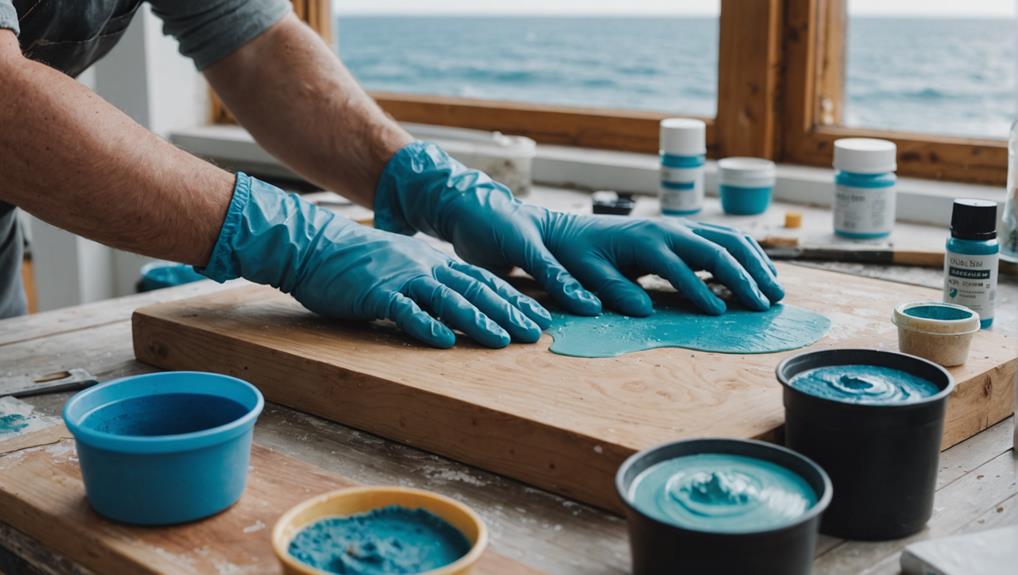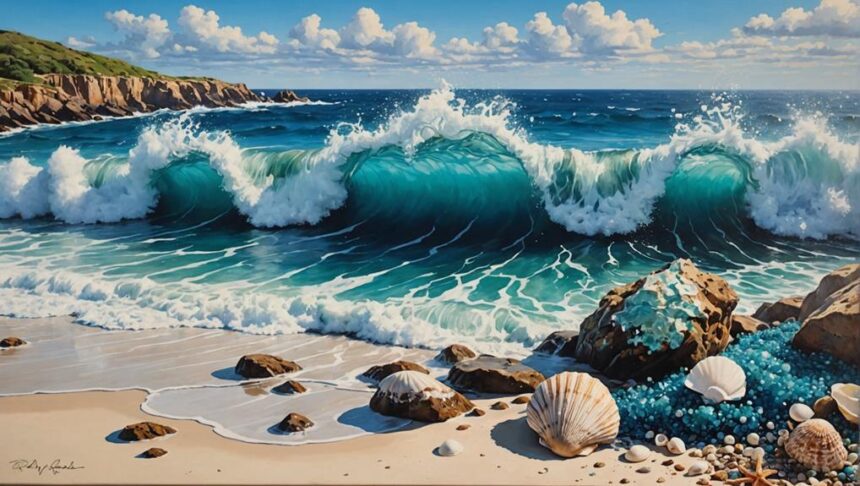Creating stunning wild coast resin art is a fun and artistic adventure! Start by gathering your supplies – epoxy resin, colorful pigments, and a solid board. Remember, safety first: wear gloves and make certain your workspace is well-ventilated. Mix your resin and pigments precisely, then pour them onto your prepared board. Use a hairdryer to create wave effects, mimicking the ocean's movement. Incorporate natural elements like sand and shells to enhance realism. Finally, let your masterpiece cure. Excited to dive deeper into this creative journey? There's a lot more to discover in each step!
Key Takeaways
- Mix resin and hardener in a 2:1 ratio using digital scales for accurate measurements.
- Use protective gear like gloves, goggles, and a 3M respirator for safe resin handling.
- Apply painter's tape to board edges to prevent resin overflow and ensure clean lines.
- Utilize a hairdryer on low to create realistic wave textures and ocean movement.
Overview of Ocean Resin Art
Ocean resin art, an enchanting fusion of creativity and technique, encapsulates the mesmerizing beauty of marine landscapes through meticulously crafted wave aesthetics and coastal elements. Imagine capturing the essence of the ocean's waves right in your artwork! The secret lies in creating intricate wave textures and mastering the art of color mixing.
Wave textures are where the magic happens. By manipulating resin with tools like a hairdryer, you can create stunning ripples and foamy waves that mimic the ocean's natural movements. It's like painting with liquid glass! The real trick is in the details, making each wave look as real as possible.
Color mixing is another vital aspect. Artists blend different pigments to achieve stunning shades of blue, green, and white, resembling the ocean's various moods. Picture the deep, mysterious blues of the open sea, shifting to the lighter, frothy whites of crashing waves. Mixing colors isn't just about beauty; it's about bringing the artwork to life.
Creating ocean resin art is a thrilling adventure, combining technical skills with artistic vision. Every piece tells a story of the sea, inviting viewers to immerse themselves in a world of swirling waters and sunlit shores.
Gathering Supplies and Tools
To bring your vision of Wild Coast Resin Art to life, it is essential to gather the right supplies and tools. These items are fundamental for crafting your masterpiece and making certain a smooth, fun process. Here's a handy list to get you started:
- Epoxy Resin and Hardener: These two components are the backbone of your artwork. Make certain you have enough, and remember, a 2:1 mixing ratio is critical for an ideal cure.
- Resin Colorants and Metallic Pigments: These bring your ocean-themed art to life with vibrant hues and shimmering effects. Choose a range of colors to create depth and realism.
- Mixing Tools: Digital scales for precise measurements, mixing pots, and sticks are necessary. Accurate mixing techniques are essential for the best results.
- Art Boards and Accessories: Secure quality art boards, tape the edges with painter's tape to avoid messy edges, and gather natural elements like sand and shells for added texture.
Don't forget the protective gear! Gloves and a hairdryer will help in safely applying the resin and achieving that stunning finish.
Also, make sure your workspace is organized and maintains a constant temperature of 20°C to guarantee the best curing conditions for your resin art.
Safety Precautions
Before you start creating your wild coast resin art, it's essential to think about safety.
Make sure your workspace is well-ventilated to keep harmful fumes at bay, and always wear protective gear like gloves, goggles, and a respirator.
Handling resin safely means understanding its potential hazards, so read the safety info carefully and keep a first aid kit nearby just in case.
Proper Ventilation Practices
Proper ventilation practices are vital when working with epoxy resin to guarantee a safe and healthy environment. When you're creating wild coast resin art, it's not just about beauty but also about staying safe. The fumes from epoxy resin can be harmful, so maintaining good air quality and using proper ventilation techniques is essential. Here's how you can do it:
- Open Windows and Use Fans: Make sure your workspace is well-ventilated by opening windows and using fans to promote airflow. This helps dissipate the fumes from epoxy resin.
- Air Purifier with HEPA Filter: Consider using an air purifier with a HEPA filter to improve air quality further. This device can capture tiny particles and keep the air cleaner.
- Outdoor or Garage Workspace: If possible, perform resin mixing and pouring outdoors or in a garage. This reduces your exposure to potentially harmful vapors.
- Take Regular Breaks: Regularly take breaks to step outside and breathe fresh air. It can help you feel more comfortable and mitigate any discomfort from prolonged exposure to resin fumes.
Essential Protective Gear
When working with epoxy resin, wearing the appropriate protective gear is essential to guarantee safety and prevent potential health risks. Imagine you're a superhero—your protective equipment is your armor.
First, always wear a 3M respirator. It's like your superhero mask, guarding you against harmful fumes even if you're using low VOC products. These fumes can be sneaky, so you need that extra layer of protection.
Next, let's talk about your hands. Nitrile gloves are a must. Think of them as your superhero gloves, saving you from skin irritation and allergic reactions when handling resin and silica gel. Resin can be harsh on your skin, so don't skip this step!
Your eyes are precious, and safety goggles are like your super cool goggles. They shield your eyes from any accidental splashes of resin or other irritants that might come your way. Imagine a splash of resin hitting your eye—ouch!
Safe Resin Handling
Guaranteeing safe resin handling involves adhering to stringent safety precautions to protect yourself and your workspace from potential hazards. Resin toxicity can be dangerous, so it's vital to follow these guidelines to keep things safe and fun.
First, always wear protective clothing, gloves, and eye protection. This gear helps prevent skin irritation and shields your eyes from splashes.
Second, make sure your workspace is well-ventilated. Proper airflow minimizes the inhalation of fumes, which is super important when mixing and pouring resin.
Third, read and follow all safety information provided with the resin materials. Knowing specific handling and storage guidelines can save you a lot of trouble.
Fourth, maintain a consistent temperature of 20°C in your workspace. This guarantees proper curing and performance of the resin.
Here's a quick checklist to keep things simple:
- Protective Gear: Gloves, eye protection, and clothing.
- Ventilation: Ensure good airflow.
- Safety Information: Read and follow guidelines.
- Consistent Temperature: Keep it around 20°C.
Don't forget about safe disposal of resin materials, either. Improper disposal can harm the environment, so always follow local regulations.
Measuring and Mixing Resin
Accurate measurement and thorough mixing of resin and hardener are vital steps in achieving high-quality resin art.
To start, it's important to understand different resin types and their specific requirements. For creating stunning wild coast resin art, we typically use a 2:1 ratio of resin to hardener. Using digital scales guarantees you measure these components precisely. Remember, accuracy here is key to avoid a sticky mess or a brittle finish.
Once measured, the mixing techniques come into play. Pour the resin and hardener into a clean mixing pot. Stir them together thoroughly for at least six minutes. This might seem like a long time, but trust me, it's vital. You want every bit of resin and hardener to blend perfectly, or else you might end up with cloudy patches. Keep a steady pace and scrape the sides and bottom of the pot frequently.
After mixing, let the resin sit for a few minutes. This helps any bubbles rise to the surface and pop, which makes your final piece clearer. Make sure your workspace is at a constant 20°C to guarantee proper curing.
Now, you're ready to move on to the next exciting step!
Preparing the Boards

With your resin mixture ready, the next step involves meticulously preparing your art boards to secure a flawless finish. Proper board preparation and surface cleaning are essential to achieving a stunning Wild Coast resin art piece. Here's a detailed guide to set you up for success:
- Select a Suitable Art Board: Choose a board that is smooth and sturdy. Confirm it is free of dents and scratches for a seamless resin application.
- Clean the Surface: Before you start, make certain the board is spotless. Wipe it down with a lint-free cloth to remove any dust or debris. This step is vital for a smooth finish.
- Tape the Edges and Underside: Use resin tape to cover the edges and bottom of the board. This prevents resin spills from causing a mess and helps achieve clean edges.
- Elevate the Board: Place the board on painter's pyramids, plastic cups, or even LEGO blocks. This allows the resin to flow freely and prevents it from sticking to your workspace.
Additionally, maintain a workspace temperature of around 20°C to guarantee proper curing.
Preparing your boards ahead of time minimizes the risk of bubbles forming in the resin, setting the stage for a breathtaking oceanscape.
Follow these steps closely for a perfect start!
Creating the Oceanscape
To create the oceanscape, start by mixing 150g of total resin, divided into three pots for the Topaz Green, Indigo Blue, and metallic pearl colors. These ocean color combinations will bring your art to life. Once mixed, pour each color onto your art board, letting them blend naturally. Use a hairdryer on a low setting to create ripple techniques, mimicking the ocean's movement.
While working, keep your workspace clean and use painter's tape on the edges of your board to avoid resin overflow. This guarantees a neat finish. Manipulate the resin with the hairdryer to create dynamic wave patterns, adding depth and realism to your piece.
Here's a quick guide to help you along:
| Step | Description | Tools Needed |
|---|---|---|
| Mix Resin | Combine 100g resin and 50g hardener | Measuring cups, sticks |
| Divide Resin | Split into three pots for coloring | Separate containers |
| Apply Colors | Pour Topaz Green, Indigo Blue, metallic pearl | Mixing sticks |
| Create Ripples | Use hairdryer on low to form wave effects | Hairdryer |
| Clean Workspace | Use tape to avoid overflow | Painter's tape |
Allow the resin to cure for at least 5 hours. This step is vital for guaranteeing your oceanscape sets properly before you add any more details. Enjoy the process, and watch your stunning wild coast scene emerge!
Designing the Beach Scene

Begin the beach scene by mixing 75g of resin (50g resin and 25g hardener) with 50g of sand to establish a solid foundation. This mixture mimics the sandy shore perfectly.
Pour the sand-colored resin at the edge closest to you, carefully spreading it with a popsicle stick or plastic knife. Make sure to maintain a natural curve to replicate a real beach's contours.
Next, prepare the ocean layer using a 120g batch (80g resin and 40g hardener). Start with dark turquoise for the deeper water and gradually blend in lighter turquoise for that dreamy gradient effect. Leave a small gap along the shoreline when pouring the light turquoise; this prevents muddy colors and keeps the beach aesthetics sharp and clean.
To create realistic waves, apply a thin line of white resin between the beach and ocean. Use a hairdryer on a low setting to form beautiful lacing effects and wave techniques.
Here's a quick recap:
- Mix 75g resin with 50g of sand for the beach.
- Spread sand-colored resin with a popsicle stick.
- Pour dark and light turquoise resin for the ocean.
- Use a hairdryer to create wave effects.
These steps will give your beach scene the perfect balance of beauty and realism.
Community Engagement
Engaging with the community is a fun and important part of creating Wild Coast Resin Art.
Sharing your creations on social media platforms like Instagram and Facebook can help you connect with other artists and get valuable feedback.
Participating in art contests and sharing tutorials online not only showcases your talent but also inspires others to experiment and grow their skills.
Share Your Creations
Connecting with a community of fellow artists can greatly enhance your creative journey by providing opportunities to share your ocean-inspired resin art on social media and engage in meaningful exchanges.
Sharing your creations not only spreads joy but also opens doors to new ideas and techniques that can fuel your artistic expression and creative inspiration. Here are some ways to get started:
- Use Dedicated Hashtags: Sharing your resin art on social media platforms with specific hashtags can increase its visibility. This helps you connect with other artists who share your passion.
- Participate in Contests: Enter online contests like the Water Contest to showcase your talent. It's a great way to gain recognition and maybe even win some cool prizes.
- Join Art Groups or Forums: Being part of resin art groups or forums allows you to share your work, get constructive feedback, and learn from others. It's like having a virtual art classroom.
- Highlight Your Journey: When you post your art, talk about your unique process and the techniques you used. This can inspire others and create a supportive environment for everyone.
Engage on Social Media
Leveraging social media platforms such as Instagram, Facebook, and Pinterest can greatly expand the reach of your resin art and connect you with a vibrant community of like-minded artists. Using effective social media strategies helps build audience engagement, fosters collaboration, and promotes your work to a broader audience.
One way to enhance engagement is by actively participating in online art communities. Share your techniques, tips, and project updates to inspire others and learn new methods. Highlighting recent winners and success stories can motivate others to share their artwork, leading to a supportive and dynamic community.
Regularly posting articles and tutorials is another great way to keep your audience informed and engaged. This approach not only educates but also keeps everyone updated on the latest trends in resin art. Encouraging feedback and comments on your posts can create constructive discussions and shared learning experiences.
Here's a quick guide to maximize your social media presence:
| Platform | Best Use | Engagement Tips |
|---|---|---|
| Visual storytelling | Use hashtags, post daily | |
| Community building | Create groups, host live sessions | |
| Inspiration and idea sharing | Pin regularly, use keywords | |
| YouTube | Tutorials and in-depth content | Create playlists, engage in comments |
Join Art Contests
Participating in art contests can further enhance community engagement and provide valuable opportunities for artists to showcase their resin art. Not only do these contests offer a platform for artistic growth, but they also connect you with others who share your passion.
Imagine entering the Water Contest and seeing your Wild Coast resin art celebrated by a larger audience!
Here are some contest benefits:
- Recognition and Visibility: Winning or even placing in a contest can put your work in the spotlight, leading to increased visibility and potential sales.
- Skill Enhancement: Competing pushes you to improve your technique and try new things, fostering artistic growth.
- Diverse Categories: Contests often have varied themes, like Farm to Table or Outdoor Life, allowing you to explore different artistic horizons.
- Community Engagement: Sharing your contest entries on social media can inspire others and create a supportive network.
Frequently Asked Questions
How Do You Make Coastal Resin Art?
To make coastal resin art, prepare your workspace and materials. Utilize precise color blending of sand-colored and turquoise resins to create beach textures and ocean effects. Manipulate white resin with a hairdryer for realistic wave details.
How Do You Make Resin Art Steps?
To create resin art, start by resin mixing with a precise 2:1 ratio of resin to hardener. Following thorough blending, proceed with color layering, pouring in stages and using heat tools for effects, then allow proper curing.
Is the Resin Art Business Profitable?
The resin art business can be profitable, as evidenced by Wild Coast Flower Preservation's success. Market analysis and effective pricing strategies, particularly for custom items, are essential for maximizing revenue and sustaining profitability on platforms like Etsy.
How to Make Epoxy Look Like Sand?
To achieve a sand texture in epoxy resin, mix fine sand with a light tan or beige-tinted resin. Apply it carefully, ensuring proper color blending. Slightly raise the sand layer above the ocean layer for realism.
Conclusion
Creating stunning wild coast resin art involves meticulous attention to detail and a passion for the craft.
By following the outlined steps—gathering supplies, adhering to safety precautions, measuring and mixing resin, preparing boards, and carefully designing ocean and beach scenes—artists can achieve remarkable results.
Community engagement further enriches the experience, offering opportunities to share insights and gain inspiration.
Mastery of these techniques guarantees the creation of enchanting and professional-quality resin art pieces.


Leave a Reply